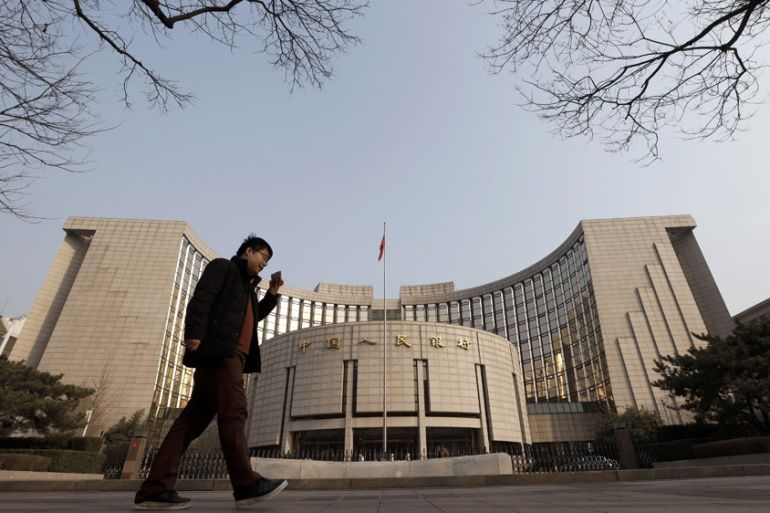China cuts reserves to lowest level since 2007
The cuts will help to offset the tightening impact of upcoming tax payments, the PBOC says.

China’s central bank said it will cut the amount of cash banks must hold as reserves to the lowest level since 2007, injecting liquidity into an economy facing both a domestic slowdown and trade-war headwinds.
The required reserve ratio for all banks will be lowered by 0.5 percentage points, taking effect on Sept. 16, the People’s Bank of China said on its website Friday.
Keep reading
list of 4 itemsUS House approves aid package worth billions for Ukraine, Israel
Ecuador weighs security, international arbitration in latest referendum
‘Triple spending’: Zimbabweans bear cost of changing to new ZiG currency
The PBOC also cut the reserve ratios by one percentage point for some city commercial banks, to take effect in two steps on Oct. 15 and Nov. 15.
The cuts will release 900 billion yuan ($126 billion) of liquidity, the PBOC said, helping to offset the tightening impact of upcoming tax payments.
That is more than the previous cuts in January and May, which released 800 billion yuan and 280 billion yuan, respectively, the PBOC said at those times.
The shift is aimed at supporting demand by funneling credit to small firms and echoes the earlier cuts this year.
While limited, it could also put pressure on the already weakening yuan which may antagonize President Donald Trump. PBOC officials indicated recently they are wary of larger-scale easing measures, and have so far refrained from following the U.S. Federal Reserve in cutting benchmark interest rates.
The cut “doesn’t reflect an aggressive easing,” said Zhou Hao, a senior emerging markets economist at Commerzbank AG in Singapore.
“In fact, China has recently massively tightened property financing. Hence this is still a re-balancing – to lower the funding costs for the manufacturing sector but tighten liquidity in the property sector due to asset bubble concerns.”
The Stoxx Europe 600 Index and S&P 500 futures extended gains after the announcement. The offshore yuan gained 0.35% to 7.1128 a dollar as of 6:30 p.m. in Beijing.
China’s economy softened again in August after poor results in July, and will likely deteriorate further in the remainder of the year.
Trade tension between China and the U.S. expanded onto the financial front recently after China allowed the currency to decline below 7 a dollar, prompting the U.S. to name it a currency manipulator.
What Bloomberg’s Economists Say…
“The PBOC has also gained more room for monetary easing, as the spread between U.S. and China 10-year government bond yields hovers near its highest level since 2018. The depreciation of the yuan also gives the PBOC more flexibility in performing monetary policy.”
– David Qu, Bloomberg Economics
The central bank emphasized that the policy change wasn’t a massive step up in easing.
“The cut is not flooding the economy with stimulus and the stance of prudent policy has not changed,” it said in a separate statement.
The RRR cut will offset the tax season in mid-September, and the overall liquidity in the banking system will stay basically stable, according to the PBOC.
“The cuts don’t mean significant easing in monetary policy,” said Ding Shuang, chief China and North Asia economist at Standard Chartered Bank Ltd. in Hong Kong.
“Rather it is something they must do, a sort of marginal easing, in order to prevent tightening in monetary policy.”